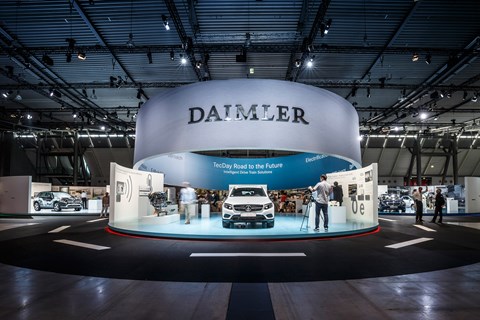► Mercedes outlines future powertrain plans
► New all-electric platform due by 2020
► Fuel cell-equipped GLC on the way
‘The rules of the game are set to change for us with the transition to zero local emissions,’ says head of Mercedes-Benz product and strategy, Wilko Stark.
Yes, Mercedes has its very own Stark – though he showed no sign of donning a flying suit and taking on any comic book characters on this occasion. Rather, speaking at a Mercedes tech day in Stuttgart entitled the road to the future, he outlined parent company Daimler’s plans to spend €14.5bn on research and development, half of which will go on green technologies, with €5.4bn heading for cars alone.
The fruits of these labours will include introducing a scalable all-electric vehicle platform before the end of the decade. But perhaps even more radically, Mercedes confirms it will put a plug-in hybrid hydrogen fuel cell version of the GLC into production in 2017.
Yet Mercedes also wants us to understand that the internal combustion engine is far from being pronounced dead, with Stark explaining that ‘not even one in 300 vehicles on the road has electric drive’ yet, and that 99% of customers are still choosing combustion engines.
Plans to keep on improving the efficiency of this ‘traditional’ technology include 48v electrics, integrated starter generators, electric compressors and improved hybridisation – starting with revised S-class 500e next year.
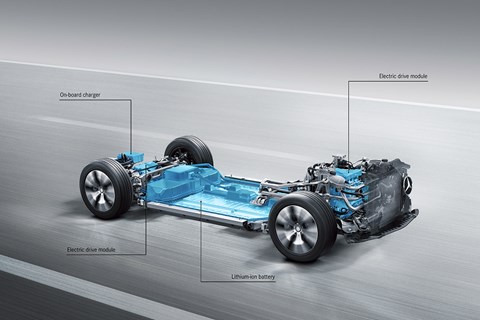
The new all-electric Mercedes-Benz
‘Nobody makes a profit these days with electric vehicles – especially not the manufacturer.’ That’s according to Prof Dr Thomas Weber, member of the board responsible for Mercedes-Benz car development. Yet Mercedes’ director of e-drive systems Jürgen Schenk says one thing about the future that’s clear is that ‘e-mobility will prevail on a large scale’.
Manufacturers are committed to reducing their fleet CO2 average to 95g/m by 2020, and increasing the number of electric cars may be the only way to do this – with Weber predicting Daimler will be selling electric mobility solutions into six figures by then. The imminent arrival of the third-generation electric Smart demonstrates Mercedes’ established credentials in this field, but it’s the all-new electric car platform that we’re really excited about.
Like the forthcoming Q6 e-tron from Audi, this will feature the latest generation lithium ion battery technology and promises a 500km range – that’s around 310 miles – on a single charge. It is also scalable, so can be packaged within different classes of car further down the line. The first model might be an SUV, like the Audi, or it may be something closer to the design of the F015 Luxury in Motion concept. More details will be announced at the 2016 Paris motor show in September.
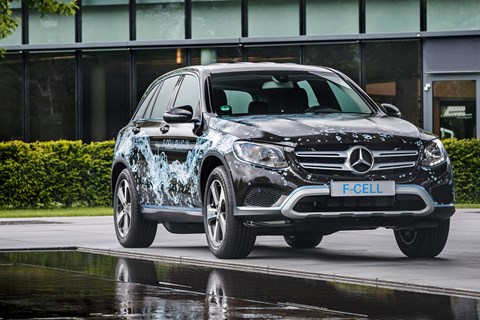
The world’s first plug-in hybrid fuel cell production car
Ahead of the all-electric platform, however, Mercedes will bring a plug-in hybrid fuel cell version of the GLC SUV to market next year. This is a world first, for while you can already buy a hydrogen powered vehicle from Toyota or Hyundai, the Mercedes GLC F-Cell has the added advantage of a battery pack you can plug into the mains, capable of delivering a 50km (31-mile) range.
The theory here is that if you find yourself running low on hydrogen, when you aren’t near a hydrogen fuel station, you will at least probably be able to find a plug. Thus the form of motivation currently most associated with range anxiety comes to absolve the range anxiety inherent in a fuel supply that is presently available only in very limited locations; together the battery and the fuel cell offer a 500km range. Hydrogen availability is improving, with Japan leading the way and Germany committed to building 400 stations by 2023.
Compared to Mercedes’ previous fuel cell unit, available for lease in the previous B-class F-Cell and tested to some two million kilometres, the one in the GLC is 30% smaller, 30% more efficient, 40% more powerful and uses 90% less platinum, helping to reduce costs.
Usefully, it also fits inside a standard Mercedes engine compartment, making it entirely possible to add hydrogen variants to other Mercedes models in the future. This would be especially easy for Mercedes with rear-wheel drive, since the GLC F-cell’s T-shaped hydrogen tank arrangement occupies the existing centre tunnel as well as replacing the conventional fuel tank; the battery pack sits above the back axle as per most plug-in hybrids.
The GLC F-cell is physically driven by an electric motor attached to the rear wheels. Mercedes won’t yet say how much it will cost – but you will be able to buy one outright and it will be offered in the UK, although perhaps not until 2018.
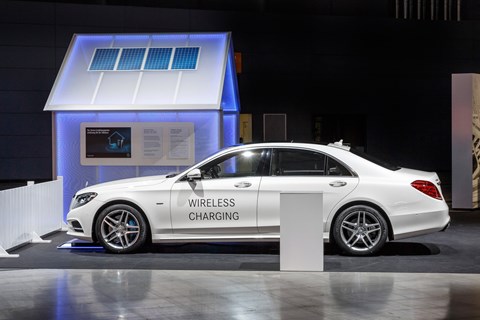
2017 S-class plug-in hybrid to feature wireless charging, petrol particulate filter
The GLC F-cell shares its 50km battery pack technology with the revised S500e, which is on sale next year. Introduced at the same time as a facelift to the current S-class, this too will be endowed with an electric range of at least 50km, using battery cell tech over 50% more efficient compared to that launched in 2013. Better yet, the S500e will also feature wireless charging capability, using inductive technology similar to your electric toothbrush.
It’s hoped the convenience of this will encourage more buyers to actually use the batteries, since they’ll no longer have to bother with plugging in any wires – instead they’ll simply position the car over a plate in the floor and leave the car to it. The system won’t cook your cat (there are sensors for that), but charging efficiency does depend on the accuracy of your parking. At its best a full charge should only take two hours.
The S500e will also feature Mercedes’ new-generation 3.0-litre straight-six petrol engine complete with particulate filter to further improve its environmental credentials – a feature previously reserved for diesels.
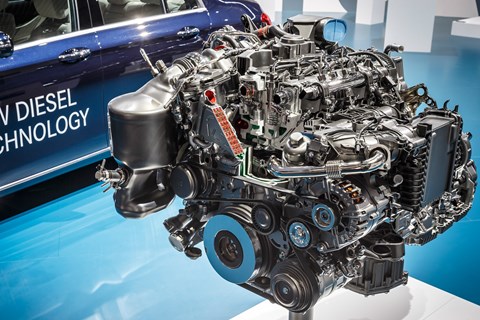
The internal combustion engine will live forever
Mercedes remains very bullish about the future of the internal combustion engine (ICE) – and diesel in particular, with Stark bemoaning the number of ‘false assertions and half-truths’ currently ‘dominating’ public discussion in this area. Not that this seems to have done any damage to Mercedes’ diesel demand, as vice president for powertrain at Mercedes-Benz cars Bernhard Heil claims it has seen no change in sales split since VW’s dieselgate issues.
Mind you, he also points out that the all-new 2.0-litre turbodiesel powering the latest E220d has been independently tested for particulate emissions, and at 60-61 milligrams per kilometre in real world driving was found to be not just below levels required for the next round of legislation coming in 2017 but the levels proposed for after that as well.
Heil firmly believes there will always be a place for internal combustion, citing developing countries limited by lack of any other infrastructure as an extreme example. Closer to home he expects 48v will become standard in the same manner as turbocharging now, since it enables efficiency enhancing technologies that will otherwise remain impossible to realise.
These technologies include ‘integrated starter generators’ – essentially an electric motor permanently engaged between the engine and the transmission, able to boost performance or save fuel, recuperate up to 80% of braking energy and even improve refinement and smoothness. ISG tech is worth a 10-15% gain in efficiency on the forthcoming S-class, apparently, but does not enable the car to move under electric power alone as the permanent connection to the engine means this is always turning.
We can also expect to see Mercedes implement ‘e-boosters’ – like the electric compressor fitted to the Audi SQ7 TDI – possibly as soon as next year, though Heil wouldn’t be drawn on exact timing. Meanwhile, 2017 will definitely see Mercedes reach a count of 10 plug-in hybrid models.
Read more Mercedes-Benz news here
